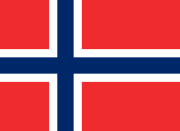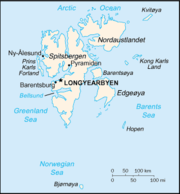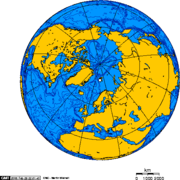Svalbard
2007 Schools Wikipedia Selection. Related subjects: European Geography
|
|
||||
 |
||||
 |
||||
| Official language | Norwegian | |||
|---|---|---|---|---|
| Capital | Longyearbyen | |||
| Governor | Per Sefland | |||
| Area - Total |
61 022 km² |
|||
| Population - Total ( 2004) - Density |
2,756 0.04/km² |
|||
| Currency | Norwegian krone | |||
| Time zone - in summer |
CET ( UTC+1) CEST ( UTC+2) |
|||
| Internet TLD | .no ( .sj allocated but not used ) | |||
| Calling Code | 47 | |||
Svalbard is an archipelago lying in the Arctic Ocean north of mainland Europe, about midway between Norway and the North Pole. It consists of a group of islands ranging from 76 ° to 81° North, and 10° to 35° East. The archipelago is the northernmost part of the Kingdom of Norway. Three islands are populated: Spitsbergen, Bjørnøya and Hopen. The largest settlement is Longyearbyen. The Svalbard Treaty recognises Norwegian sovereignty over Svalbard. With the 1925 Svalbard Act, Norway chose to make Svalbard a part of the Kingdom, and it remains one of five special entities whose status is recognized by international treaty in the world today.
History
Vikings and Russians may have discovered Svalbard as early as the 12th century. Traditional Norse accounts exist of a land known as Svalbarði — literally "cold edge". But the dutchman Willem Barents made the first indisputable discovery of Svalbard in 1596. From 1612 to 1720 whaling took place off the western coast of Spitsbergen, by Danish, Dutch, English, French and Norwegian ships. It is estimated that the Dutch alone took 60,000 whales from their base Smeerenburg. They also provided the headquarters for many Arctic exploration expeditions. Comprehensive geological mapping of the archipelago was conducted by teams from Cambridge and other universities, led primarily by W. Brian Harland from the 1940s to 1980s.
The largest island in the archipelago is called Spitsbergen (Dutch for "Jagged mountains"); this name was formerly used to refer to the entire archipelago, while the main island was called West Spitsbergen.
Politics
Svalbard is completely controlled by the Kingdom of Norway and is part of it. The Svalbard Treaty recognizes Norwegian sovereignty over Svalbard. However Norway's power over Svalbard has some limitations in taxation, environmental conservation, non-discrimination and certain military activity.
Svalbard was made a part of Norway by a Norwegian act in 1925, thus Svalbard is not a Norwegian dependency. However, under the terms of the treaty, citizens of signatory states have rights to exploit mineral deposits and other natural resources "on a footing of absolute equality". As a result, a permanent Russian settlement, more or less autonomous, grew up at Barentsburg. Another Russian settlement at Pyramiden was abandoned in 2000.
According to Per Sefland, Norway's governor on the archipelago, the Svalbard Treaty of February 9, 1920 implies that "If you're able to find a job, you have the right according to the treaty to come here." The treaty states: "The nationals of all the high contracting parties [signatories] shall have equal liberty of access and entry for any reason or object whatever to the waters, fjords and ports of the territories." Therefore, some immigrants who have been denied residence to EU countries have relocated to Svalbard.
Seed Bank
By the year 2007 the Norwegian government is planning on building a 'doomsday' seed bank in which as many species' seeds as possible will be stored. As reported by BBC News the Norwegian government will be building this bank by hollowing out a cave on Spitsbergen and then putting in as many seeds as possible with the support from countries around the world. The proposed bank will have top security blast-proof doors and would have two airlocks. The number of seeds stored will depend on the number of countries participating in the project. The initiative of this project is to prevent needed plants (wild, agricultural, etc.) from going extinct or becoming rare if a nuclear war were to break out or because of gene pollution from genetically engineered plants.
Geography
Svalbard consists of a group of islands in the Arctic Ocean ranging from 76° to 81° North and 10° to 35° East, and forms the northern-most part of Norway and the northern-most lands of Europe. The islands cover an area of 61,022 km², of which about 60% (36,502 km²) is covered by glaciation. Three large islands dominate: Spitsbergen (37,673 km² or 14,550 square miles), Nordaustlandet, (Northeast Land), (14,443 km² or 5576 square miles) and Edgeøya (Edge Island) (5074 km²or 1959 square miles) There is also the smaller Barentsøya (1,288 km²), Kvitøya (682 km²), Prins Karls forland (615 km²), Kongsøya (191 km²), Bjørnøya (178 km²), Svenskøya (137 km²), Wilhemøya (120 km²) and other smaller islands or skerries (621 km²).
Svalbard lies far north of the Arctic Circle. In Longyearbyen, the midnight sun lasts from April 20 to August 23, and polar night lasts from October 26 to February 15.
In addition to humans, four mammalian species inhabit the archipelago: the Svalbard field mouse Microtus epiroticus, the Arctic fox, the Svalbard reindeer (a distinct sub-species), and polar bears. Since polar bears occur very commonly on Svalbard, all people need to take precautions when outside the settlements: this includes carrying a rifle. Nevertheless, the law protects polar bears, forbidding anyone to harm or disturb them.
Svalbard is also a breeding ground for large numbers of seabirds, including Brunnich's and Black Guillemot, Puffin, Little Auk, Fulmar and Kittiwake. Other seabirds include Arctic Tern, four species of skua, and the elusive Ivory Gull. The Svalbard Ptarmigan, found on the larger islands, is the only land bird present for the entire year. Only two songbirds migrate to Svalbard to breed: the Snow Bunting and the Wheatear.
There is an astonishing variety of flowering plants on Svalbard. Although they are very small, these plants use the short period of 24-hour daylight to produce colourful blossoms. See also: Flowers of Svalbard.
Fjords
There are numerous fjords among the Svalbard islands; the five longest of which (measured from the head to open sea) are listed here:
- Wijdefjord, 108 km
- Isfjord, 107 km
- Van Mijenfjord, 83 km
- Woodfjord, 64 km
- Wahlenbergfjord, 46 km
Coastlines
Coastlines of the Svalbard islands (listed from largest island to smallest) show the extensive variability characteristic of glacial formation:
- Spitsbergen, 3,919 km
- Nordaustlandet, 1,688 km
- Edgeøya, 502 km
- Barentsøya, 205 km
- Kvitøya, 119 km
- Prins Karls forland, 320 km
- Kongsøya, 132 km
- Bjørnøya, 88 km
- Svenskøya, 62 km
- Wilhemøya, 58 km
- Other smaller islands and skerries, 1,736 km
Mountains
Although small when compared with the mountains of Norway, the elevation of the Svalbard island mountains accounts for much of the glacial erosion:
- Newtontopp, 1713 m
- Perriertopp, 1712 m
- Ceresfjell, 1675 m
- Chadwickrygg, 1640 m
- Galileotopp, 1637 m
Settlements
- Barentsburg (Баренцбург) (Russian settlement — population of 900)
- Bjørnøya (Norwegian weather station, population of 9)
- Grumant (Грумант) (Russian settlement, abandoned in 1961, revival of mining operations announced in 2003)
- Hopen (Norwegian weather station, population of 4)
- Hornsund (Polish research station, population of 8)
- Isfjord radio
- Longyearbyen (population of 1,800)
- Ny-Ålesund (population of 40)
- Pyramida (Пирамида) (Russian settlement, abandoned in 2000)
- Smeerenburg (Dutch settlement on northwestern Amsterdam Island, abandoned around 1660)
- Sveagruva (population of 210)
No roads link the settlements on the island; transportation includes boat, plane, helicopter, and snowmobile. The gateway to Svalbard is through Svalbard Airport, Longyear.
Climate
The North Atlantic Current moderates Svalbard's Arctic climate, keeping the surrounding waters open and navigable most of the year. The average Summer temperature is around 5 degrees Celsius (°C), and in winter, −12 °C. The Western coast is considerably warmer than the east, due to the North Atlantic Drift.
Due to its history of human occupation, Svalbard has one of the longest high-latitude meteorological records on earth. Computer models of global climate have long predicted enhanced greenhouse warming at such latitudes, so the Svalbard record is of particular interest. It shows approximately 6 °C increase in 100 years; with 4 °C increase in the last 30 years.
Economy
Economic activity centres on coal mining, supplemented by fishing and trapping. In the final decades of the 20th century, tourism, research, higher education, and some high-tech enterprises like satellite relay-stations grew significantly. A 200 nautical mile (370 km) Fisheries Protection Zone around Svalbard was established in 1977 pursuant to the Act of 17 December 1976 relating to the Economic Zone of Norway. Despite recent discussions, Russia and Norway dispute their maritime limits in the Barents Sea and Russia's fishing rights beyond Svalbard's territorial limits within the Svalbard Treaty zone.
The Svalbard Undersea Cable System which started operation in January 2004 provides dual 1440 km fibre optic lines from Svalbard to Harstad via Andøy, needed for communicating with polar orbiting satellite stations on Svalbard, some owned by the National Aeronautics and Space Administration (NASA) and the National Oceanic and Atmospheric Administration (NOAA), both United States government agencies.
The Norwegian state-owned coal company employs nearly 60% of the Norwegian population on the island, runs many of the local services, and provides most of the local infrastructure. Coal production has increased significantly over the past 10 years, rising from less that 500,000 tons in 1994 to over 2,500,000 tons in 2004.
Exploration for oil and natural gas is underway.
Coal mining in Svalbard
The first modern coal mine was opened in 1906 when the Arctic Coal Company (ACC) set up camp. The settlement that grew up around the mine was named after the American owner of ACC, John Munroe Longyear. However ACC sold out to the Store Norske Spitsbergen Kulkompani (SNSK) in 1916, and over the next few years two other Norwegian companies set up operations on the southernmost island, Bjørnøya, and the Kings Bay Kull Compani opened a mine in Ny Ålesund.
Mining came to a halt during WWII, and the islands were evacuated on the 3rd of September 1941. However the Germans did bomb Longyearbyen and the Barentsburg settlement in September 1943 and the settlement of Sveagruva the year after.
The Ny Ålesund mine was closed down in 1963 after an explosion in 1962 when 21 lives were lost, and has since been converted to a scientific post.
As of 2006, there are three operational coal mines in Svalbard. There are large mines in Sveagruva (production 2 million tonnes per year, and Barentsburg, while the small mine in Longyearbyen is used mainly to supply the town's own power plant.
Demographics
Svalbard has a population of approximately 2,400 people as of 2005. Approximately 70% of the people are Norwegian; the remaining 30% are Russian, Ukrainian and Polish. The official language of Svalbard is Norwegian. Russian is used in the Russian settlements, but formerly, Russenorsk was the lingua franca of the entire Barents Sea region.
| Year | Total | Norwegian | Russian | Polish |
|---|---|---|---|---|
| 1990 | 3,544 | 1,125 | 2,407 | 12 |
| 1995 | 2,906 | 1,218 | 1,679 | 9 |
| 2000 | 2,376 | 1,475 | 893 | 8 |
| 2005 | 2,400 | 1,645 | 747 | 8 |
Svalbard in popular culture
Svalbard featured as the setting for much action in Philip Pullman's His Dark Materials trilogy. A gateway was created there from which one could gain access to parallel universes. The Svalbard in the books is ruled by a race of sentient armored polar bears ( Panserbjørne).


